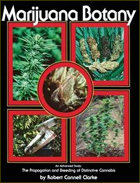
by Robert Connell Clarke
Floral Maturation
The individual pistillate calyxes and the composite floral clusters change as they mature. External changes indicate that internal biochemical metabolic changes are also occurring. When the external changes can be connected with the invisible internal metabolic changes, then the cultivator is in a better position to decide when to harvest floral clusters. With years of experience this becomes intuition, but there are general correlations which can put the process in more objective terms.
The calyxes first appear as single, thin, tubular, green sheaths surrounding an ovule at the basal attached end with a pair of thin white, yellowish green, or purple pistils attached to the ovule and protruding from the tip fold of the calyx. As the flower begins to age and mature, the pistils grow longer and the calyx enlarges slightly to its full length. Next, the calyx begins to swell as resin secretion increases, and the pistils reach their peak of reproductive ripeness. From this point on, the pistils begin to swell and darken slightly, and the tips may begin to curl and turn reddish brown. At this stage the pistillate flower is past its reproductive peak, and it is not likely that it will produce a viable seed if pollinated. Without pollination the calyx begins to swell almost as if it had been fertilized and resin secretion reaches a peak. The pistils eventually wither and turn a reddish or orange brown. By this time, the swollen calyx has accumulated an incredible layer of resin, but secretion has slowed and few fresh terpenes and cannabinoids are being produced. Falling pistils mark the end of the developmental cycle of the individual pistillate calyx. The resins turn opaque and the calyx begins to die. The biosynthesis of cannabinoids and terpenes parallels the developmental stages of the calyx and associated resin-producing glandular trichomes. Also, the average developmental stage of the accumulated individual calyxes determines the maturational state of the entire floral cluster. Thus, determination of maturational stage and timing of the harvest is based on the average calyx and resin condition, along with general trends in morphology and development of the plant as a whole.
The basic morphological characteristics of floral maturation are measured by calyx-to-leaf ratio and internode length within floral clusters. Calyx-to-leaf ratios are highest during the peak floral stage. Later stages are usually characterized by decreased calyx growth and increased leaf growth. Internode length is usually very short between pairs of calyxes in tight dense clusters. At the end of the maturation cycle, if there is still growth, the internode length may increase in response to increased humidity and lowered light conditions. This is most often a sign that the floral clusters are past their reproductive peak; if so, they are preparing for rejuvenation and the possibility of regrowth the following season. At this time nearly all resin secretion has ceased at temperate latitudes (due to low temperatures), but may still continue in equatorial and subtropical areas that have a longer and warmer growing season. Greenhouses have been used in temperate latitudes to simulate tropical environments and extend the period of resin production. It should be remembered that greenhouses also tend to cause a stretched condition in the floral clusters in response to high humidity, high temperatures, lowered light intensity, and restricted air circulation. Simulation of the native photoperiod of a certain strain is achieved through the use of blackout curtains and supplemental lighting in a greenhouse or indoor environment. The localized light cycle particular to a strain may be estimated from the graph of maturation patterns at various latitudes. In this way it is possible to reproduce exotic foreign environments to more accurately study Cannabis. Tight clusters of calyxes and leaves are characteristic of ripe outdoor Cannabis. Some strains, however, such as those from Thailand, tend to have longer internodes and appear airy and stretched. This seems to be a genetically controlled adaptation to their native environment. Imported ~1 examples from Thailand also have long internodes in the pistillate floral clusters. Thai strains may not develop tight floral clusters even in the most arid and exposed conditions; however, this condition is furthered as rejuvenation begins during autumn days of decreasing photoperiod.

